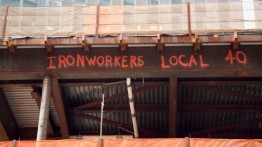Ironworkers Give Students a Lesson in Heavy Metal
POSTED ON: April 26, 2016

Ironworkers from Local 40 make their mark at the World Trade Center site.
On April 25, Prof. Cosmas Tzavelis and a group of students from his interdisciplinary course Testing Building Materials (CE 391) visited the headquarters of New York City Ironworkers, Locals 40 and 361, which represent structural ironworkers in New York City. The Cooper contingent was welcomed at the union’s Astoria building by Gary Higbee, Director of Industry Development for the Steel Institute of New York and the Ornamental Metal Institute of New York, and Brian Brady, Training Director for the Joint Apprenticeship Program offered by the two locals. The program trains aspiring ironworkers, a rigorous 3-year apprenticeship with participants who work on construction sites by day and take classes at night.
“It’s very competitive to get into the program,” Mr. Brady said. “It’s good, well paid work, but it’s dangerous.” Speaking in the program’s central classroom, he explained the training process for becoming an ironworker and outlined how various crews go about erecting skyscrapers—from the “plumbing up gang” who insure that foundational columns are as straight as possible to the “raising gang,” the “bolt up gang,” "the decking gang,” and the “welding gang.” Workers called “the connectors” are deemed the rock stars of the industry because, while climbing on steel structures thousands of feet above ground, they must bolt massively heavy beams into place. Mr. Brady showed the group a video highlighting the program and the work done by its graduates.
After learning about the training and building process, students visited the workshops where ironworkers learn to scramble up steel girders, bolt beams and weld. Fitted with heavy suede jackets and protective head and eye gear, each student got the chance to try two welding methods.
Amos Chung, a senior in civil engineering and a design captain for Cooper’s Steel Bridge team, said that the visit gave him “a deeper appreciation of the industry, now knowing how difficult stick welding and column climbing can be, and how rigorous bolting procedures are. I was so excited to use their equipment to cut and weld steel ourselves, and see how the steel connections we design in our coursework are actually made.”
Prof. Tzavelis’s class, made up of architects and engineers, has been studying the properties of building materials. For their final project, groups of four will work to construct a model of a 3-story house that can hold live loads of 100 pounds per square foot. The model will be tested for its gravitational and lateral strength. Prof. Tzavelis designed the class three years ago in an effort to meet the needs of both architecture and engineering students.
Mr. Higbee arranged for the visit to the training center as part of his group’s continued support of Cooper Union students. In addition to funding lectures for students in fields related to the steel industry, The Steel Institute of New York and The Ornamental Metal Institute of New York contribute instructional manuals for architecture and engineering students on materials. In addition, The Steel Institute provides funding for Cooper’s Steel Bridge team, which recently placed first in the regional Steel Bridge competition, to travel to Utah to take part in the national competition.




